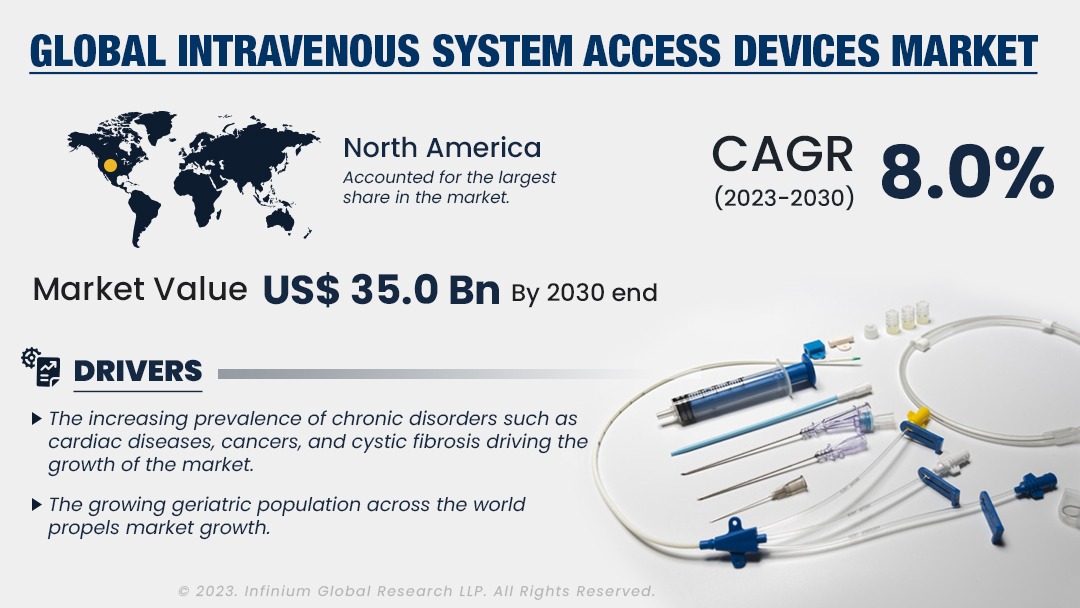Intravenous System Access Devices Market (Product Type - Implantable Port, Intravenous Catheter, Hypodermic Needles, Infusion Pumps, and Others; Application - Medication Administration, Fluid and Nutrient Administration, Blood Transfusion, and Diagnostics; End User - Hospitals, Clinics, and Ambulatory Surgery Centers): Global Industry Analysis, Trends, Size, Share and Forecasts to 2030
A recent report published by Infinium Global Research on intravenous system access devices market provides in-depth analysis of segments and sub-segments in the global as well as regional intravenous system access devices market. The study also highlights the impact of drivers, restraints, and macro indicators on the global and regional intravenous system access devices market over the short term as well as long term. The report is a comprehensive presentation of trends, forecast and dollar values of global intravenous system access devices market.
Market Insight:
Intravenous treatments involve the use of a wide range of medical devices. Intravenous systems are used for patients that need intravenous medication, or nutrition. Intravenous or vascular system access devices enable repeated and long-term access to the bloodstream for frequent and regular administration of drugs, or nutrition. It typically goes into a large vein in the arm or chest. Intravenous system access devices, such as Peripherally Inserted Central Catheters (PICCs) are generally used for days, weeks, or months. While, other devices, such as ports, are used for patients that require medication for years. Moreover, a wide range of intravenous system access devices is available in the market including peripherally intravenous catheters, infusion pumps, and implantable ports. The market players are offering differentiated intravenous system access devices for different applications to differentiate themselves from the competition.
The rising incidence of chronic diseases such as diabetes, rheumatoid arthritis, and multiple sclerosis is one of the primary drivers of the reusable electric auto-injector market. These conditions often require regular self-injections, and reusable electric auto-injectors offer a more convenient and precise method of drug delivery. Additionally, the growing geriatric population across the world propels the market growth. However, medical complications associated with intravenous access devices may hinder the market growth. Although, the continuous advancements in technology and the increasing demand for more user-friendly, automated drug delivery systems have led to the development of advanced reusable electric auto-injectors. These devices offer improved accuracy, precision, and ease of use, which has led to increased adoption among patients and healthcare providers. Further, provide growth opportunity for the market.

In terms of region, the global intravenous system access devices market is segmented into North America, Europe, Asia-Pacific, and the Rest of the World. The North American region accounted for the largest share in the global intravenous system access devices market. The domination of North America is mainly attributed to the higher incidence rate of chronic disorders such as cancer, and heart disease. Moreover, the growing geriatric population in North America is further augmenting the growth of the intravenous system access device market in the region. On the other hand, the Asia Pacific intravenous system access device market is anticipated to grow at the fastest rate among the regions. The large patient pool in the Asia Pacific is majorly driving the growth of the intravenous system access devices market in the region. In addition, the improving healthcare sector and growing expenditure on healthcare in augmenting the demand for intravenous system access devices in the Asia Pacific.
Report Scope of the Intravenous System Access Devices Market:
| Report Coverage | Details |
|---|---|
| Market Size in 2022 | Approximately USD 19 Billion |
| Market Size by 2030 | Nearly USD 35 Billion |
| Growth Rate from 2023 to 2030 | CAGR of About 8% |
| Largest Market | North America |
| No. of Pages | 255 |
| Market Drivers |
|
| Market Segmentation | By Product Type, By Application, and By End User |
| Regional Scope | North America, Europe, Asia Pacific, and RoW |
Segment wise revenue contribution in the global intravenous system access devices market
The report on global intravenous system access devices market provides a detailed analysis of segments in the market based on Product Type, Application, and End User.
Segmentation Based on Product Type
· Implantable Port
· Intravenous Catheter
· Hypodermic Needles
· Infusion Pumps
· Others
Segmentation Based on Application
· Medication Administration
· Fluid and Nutrient Administration
· Blood Transfusion
· Diagnostics
Segmentation Based on End User
· Hospitals
· Clinics
· Ambulatory Surgery Centers
Company Profiled:
· B. Braun SE
· BD
· Smiths Medical (is now part of ICU Medical, Inc.)
· Terumo Corporation
· Teleflex Incorporated
· Edwards Lifesciences Corporation
· Medical Components, Inc.
· ICU Medical
· Fresenius Medical Care AG & Co. KGaA
· Becton Dickinson (acquires C.R. Bard)
Report Highlights:
The report provides deep insights into demand forecasts, market trends, and micro and macro indicators. In addition, this report provides insights into the factors that are driving and restraining the growth in this market. Moreover, The IGR-Growth Matrix analysis given in the report brings an insight into the investment areas that existing or new market players can consider. The report provides insights into the market using analytical tools such as Porter's five forces analysis and DRO analysis of the intravenous system access devices market. Moreover, the study highlights current market trends and provides forecasts from 2023-2030. We also have highlighted future trends in the market that will affect the demand during the forecast period. Moreover, the competitive analysis given in each regional market brings an insight into the market share of the leading players.
